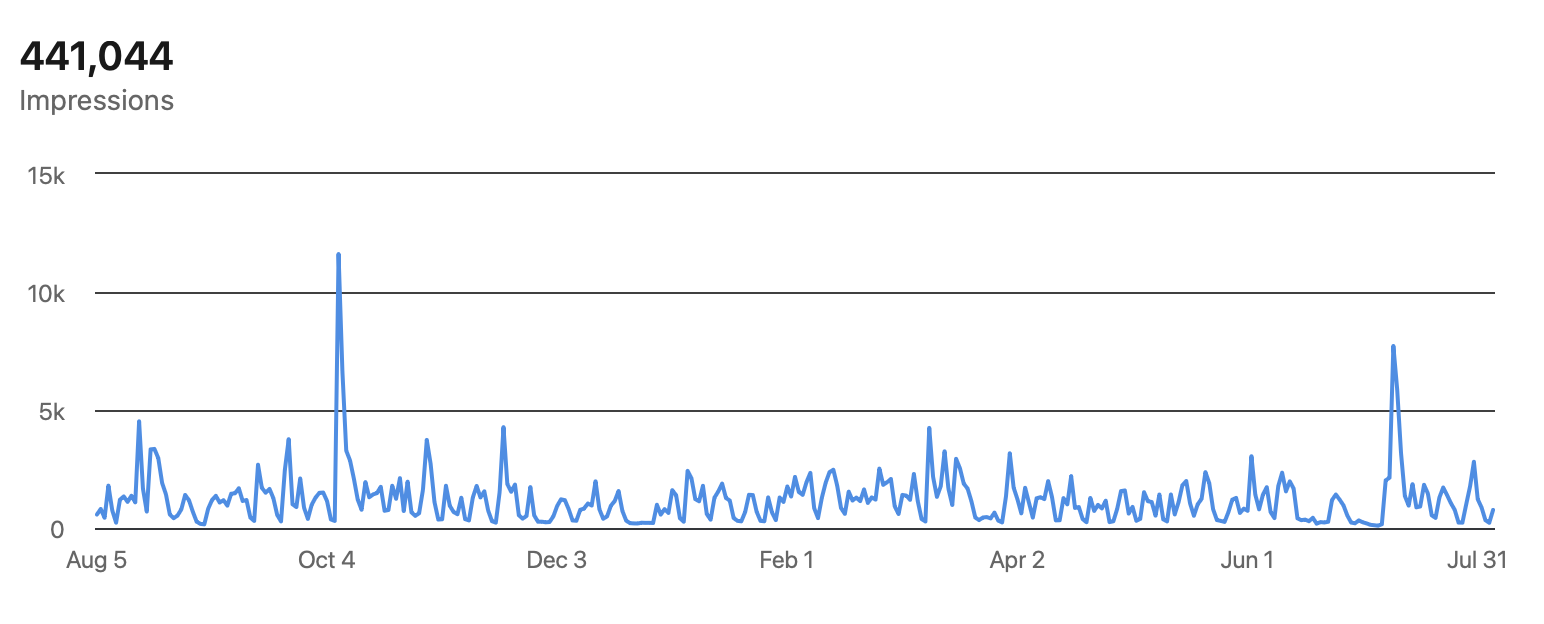In this Article:
If there’s one piece of advice we hammer home to every founder, partner, and practice leader we work with on Authority Marketing, it’s this:
Please. I’m begging you. Be consistent on LinkedIn.
Consistency isn’t sexy. But it is strategic. And for firms that rely on trust, expertise, and relationships to win business, consistency is absolutely critical.
Let’s unpack why.
The Math Works
Mere exposure effect is real. The data suggests that prospects need to be exposed to your ideas more than 20 times before reaching out. But 20 touches doesn’t have to mean emails or voicemails.
Below is the impression data for my own LinkedIn account over the last year. No posts went super-viral - it's just a function of consistency. And the four most common job titles? Founder, Co-Founder, CEO, President. And those impressions are directly attributable to 54 inbound strategy calls booked on my calendar - roughly one a week.

LinkedIn is the only channel that lets you show up 100–150 times a year in the feeds of your ideal clients. No cold email campaign can do that (without burning your reputation). No ad campaign can touch it in terms of cost-efficiency. No blog post, no matter how brilliant, will get that kind of recurring exposure. Even this one 🙂.
This might change in the future. But as of 2025, LinkedIn stands alone in this regard.
The algorithm rewards consistency. It doesn’t require you to go viral. It just requires that you keep showing up. And when you do, it quietly builds familiarity over time.
A managing partner at a fund sees your name three times in one week and suddenly they’re replying to your DM. A startup founder bookmarks a post about QSBS and circles back six months later when their round closes. A potential client tags a colleague under your post about value-based pricing, and that colleague clicks through to your profile.
These micro-moments are how you build trust. But it only happens if you stick with it. If you build a publishing habit. If you decide, “I’m going to show up once or twice a week, no matter what.”
Likes Are Not the Goal
One reason we see people struggle is the social validation (or lack thereof). They post once or twice, get 8 likes, and feel deflated. “No one cares,” they think. “This isn’t working.”
When you’re just starting out, this is normal. You have 200 connections. Maybe 10% of them will see your stuff in the beginning. It’s unrealistic to expect to have thousands of people see your stuff in the beginning. This is an investment in your long-term success. Not an overnight fix.
Even when you have a larger audience, LinkedIn still isn’t about going viral. It’s about being seen by the right people, with the right message, at the right time.
Generally speaking the posts that get clients aren’t the ones that get a ton of engagement. They’re specific. Tactical. Usually speaking to a pretty advanced topic that your Ideal Client will resonate with but other folks won’t. They’re the kind of post someone screenshots and slacks to a colleague with a note: “This is what I was trying to explain.”
These are the kinds of posts that build trust over time. They build (usually subconsciously) the idea in the mind of your ICP that “this person knows what they’re talking about.”
Most people who put time on our calendars never like or comment on anything we write. They’re lurkers. But they see it.
The Visibility Matters, Even if They Don’t Read It
Not every post gets read. Some get skimmed. Some get ignored.
But that’s not a failure. Because even if someone scrolls past your post, they still see your name, your face, your headline.
And those tiny impressions stack up.
Every time you post, you’re reinforcing your positioning. You’re reminding people what you do, who you do it for, and how you think. You’re giving your audience little signals that say: “Still here. Still helpful. Still paying attention to your world.”
This is where consistency pays off in ways that are hard to measure, but easy to feel over time.
When folks do raise their hands and get on a call with you, it’s likely they won’t even know which post did it. Because it wasn’t one post. It was the cumulative effect of your consistency.
You Have an Obligation
If you’re a senior leader at your firm, you have a responsibility to increase its visibility.
You may not love the idea of posting. You may feel awkward or exposed. You may tell yourself you’re too busy
But the 22-year-old associate at your firm isn’t going to do it. They don’t have the perspective yet. They don’t know what they don’t know. You do.
You’ve been in the trenches. You’ve seen the patterns. You’ve helped clients navigate thorny issues. You’ve accumulated decades of insight that, if shared, could help someone else move faster, avoid mistakes, or make better decisions.
Stop thinking about sharing your ideas as self-promotion. It’s leadership. It’s an act of stewardship for the people you serve.
You don’t need to be brilliant every time. You just need to show up with something honest and useful.
Objections We Hear (And Why They Don’t Hold Up)
Let’s address a few common hesitations we hear from clients:
“I don’t have time.”
You don’t need to spend hours writing. A short paragraph with a smart observation is enough. And with a little support (like our Authority Marketing service) it becomes sustainable.
“I don’t know what to write about.”
We promise you do. You’re sitting on an ocean of ideas: things you say to clients every week, internal frameworks you’ve refined, patterns you’re noticing, questions people ask you again and again. That’s all raw material.
“It feels self-indulgent.”
Not if you focus on service. If your posts are designed to help, not to impress, you’re in safe territory.
“What if people disagree?”
That’s okay. You’re not trying to please everyone. You’re trying to find the people who resonate with your approach.
How to Get Started (and Stick With It)
If you’re ready to make LinkedIn a core part of your visibility strategy, here’s how to start:
Pick a Posting Cadence You Can Actually Stick To
One post per week is a great starting point. Two is better. But don’t aim for daily if you’ll burn out by week three.
Focus on 3–5 Core Themes
What do you want to be known for? Pick a few topics you can return to again and again. These should align with your services, your values, and your clients’ pain points.
Write Like You Talk
Don’t overthink the tone. Clarity beats cleverness. If you wouldn’t say it in a client meeting, don’t say it on LinkedIn.
Repurpose Ideas You Already Use
Turn slide decks into posts. Reuse client emails (anonymized, of course). Build on questions you answered last week. You don’t need to invent new ideas. Just package what’s already in your head.
Measure Progress by Conversations, Not Likes
It’s not direct response. It’s a lot more like brand. So track the right metric. After several months of doing this, are you getting new intros? More relationships? That’s ultimately what matters.
Just Try to Serve
If you shift your mindset from “performance” to “service,” everything changes.
Each post becomes a small act of generosity. A breadcrumb that leads your ideal client closer to trusting you.
You don’t need to worry about likes or reach. Just focus on sharing your ideas consistently. Giving away your secrets. Your team will notice. Your prospective clients will notice. And in time, you’ll have an inbound pipeline you can be proud of.
Don’t know where to start? Bought in to the idea, but too busy to do it yourself? Our Authority Marketing services are designed to help busy professional services executives show up with consistency. Learn more here.

